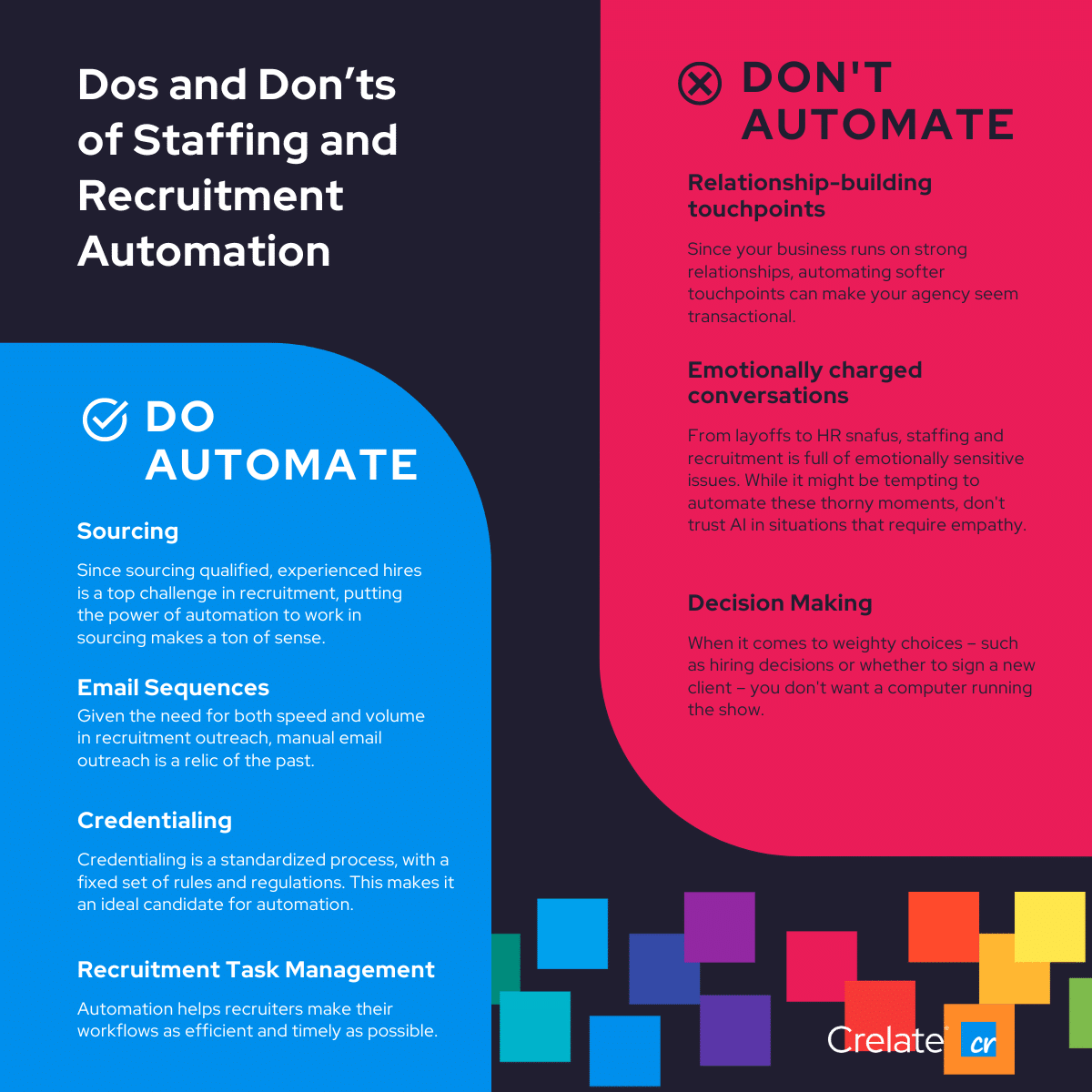
Right now, everyone in staffing and recruiting is trying to figure out the role automation plays in the industry. It’s role isn’t a small one: automation can help you place more candidates, improve productivity, and generate more revenue.
And our industry isn’t alone. Over 60% of businesses use automation to solve bottlenecks in their daily workflows.
But like every technology-based solution, there’s a right way and a wrong way to bring automation into your staffing and recruiting business.
So, before we look at what to automate, let’s take a quick look at why we automate.
Automation doesn’t replace work that only humans can do, but it is very useful for taking busywork off of your recruiters’ desks so that they can focus on what really matters: building relationships.Chris Hesson put it like this on a recent podcast episode, “The idea [of automation] is let’s take manual effort steps, let’s take the busy work off of [a recruiters’] plates so they can focus on the things that require a human brain.
They can focus on conversations. I mean, ideally, if you could have your team on the phone, not making phone calls, but talking to people all day, every day, how much better would you guys be? How much better of a position? How many more relationships could you get to?”
So, smart automation clears the path for your recruiters to do what they do best: grow the relationships that grow your business.
With that in mind, here’s what you should and shouldn’t automate in staffing and recruiting.
Things you should automate in staffing and recruiting
Sourcing
Over 60% of those surveyed in Deloitte’s Global Human Capital Trends Survey found that recruitment’s biggest challenge is sourcing qualified, experienced hires. So, putting the power of automation to work to source more candidates makes a ton of sense. In fact, in a recent survey, 70% of respondents agreed that sourcing automation would increase productivity.
- Turn your website into a lead-generation machine by automating your first-in-line touchpoint
- Spotlight your open positions on job boards that are integrated into your website and update seamlessly
- Auto-populate your open positions to leading job boards to ensure that top candidates come to you
- Cut time-to-hire with AI-driven talent sourcing tools like humanpredictions, HireEZ, SeekOut, and ZoomInfo Talent OS
Email sequences
Though text and social messaging have seen a rise in popularity throughout the staffing and recruiting industry in the past five years, email outreach is still the bread and butter for many teams.
And, now more than ever, the faster you are, the more likely you are to succeed. The agency that reaches candidates first with the right message is often the one to win their contract. Given the need for both speed and volume, along with thoughtful messaging, manual email outreach is a relic of the past.
With the right email automation tools, your team can:
- Trigger email sequences based on user actions
- Create segmented workflows, such as those for active candidates or passive candidates, to target folks when they’re most likely to act
- Move candidates through the different stages of their journey with you via well-timed email outreach
- Keep your firm top-of-mind with clients with regular nurturing emails, sharing evergreen industry tips, relevant research, and other valuable info
Credentialing
Credentialing is a common bottleneck in the staffing and recruiting process, especially in high-volume industries like travel nursing and locum tenens.
Credentialing is a standardized process, and though it has many intricacies, it is subject to a fixed set of rules and regulations. This makes it an ideal candidate for automation.
Automated credentialing can:
- Automatically generate background checks to fulfill candidate screening needs
- Schedule credentialing workflows to move candidates through the screening process
- Alert recruiters, candidates, and clients when key credentials are set to expire
- Keep all constituents in your agency aware of changing statues and requirements
Recruiting task management
The most efficient staffing and recruiting workflows in the world will fall flat if recruiters aren’t aware of the tasks they need to accomplish to get candidates to the finish line. Your team is likely inundated with information, and prioritizing what to act on can slow them down and drain their energy.
In fact, people make upwards of 35,000 decisions each day, which can slow down our brains like an overloaded CPU. When your team has to make too many decisions – such as whether to complete tasks in their inbox or churn through the list of phone calls they have to make – they are more likely to make the wrong decision. The key – you guessed it – is automation.
- Automated notifications from within your ATS prioritize next steps for your team
- Ensure that your recruiters respond in real-time to the most urgent candidates and client requests
- Eliminate decision fatigue for your team and keep them working at their most efficient

When you should NOT rely on automation
Though automation is powerful in saving time, improving efficiency, and streamlining rote processes, your team should not try to automate everything. While it’s tempting to believe that every facet of recruiting can benefit from more technology, balance is crucial.
Staffing and recruiting agencies also face a risk of becoming too transactional. Many candidates are primed to assume that new agencies see them as just another number. Since this is a prominent aspect of the industry’s reputation, anything your firm does to feed into that stereotype risks driving candidates away.
Over-automation plays into that stereotype. It can make your recruiters seem robotic and give your firm a reputation for being overly transactional.
With that in mind, let’s take a look at some of the aspects of your recruiting process that should not be automated.
Relationship-building touchpoints
Your staffing and recruiting agency thrives on people, which means that building strong relationships is synonymous with building a strong business. You want to be careful, then, not to automate away the parts of your process that help your prospects and candidates feel safe, heard, and trusting.
A good way to gauge which aspects of your process are most important for building relationships is to simply ask your candidates. Soliciting feedback through a survey or quick email can let you know what touchpoints are most valuable – and which ones might be best automated out of your recruiter‘s hands.
For example, if you regularly receive feedback that introductory phone calls are popular with prospects, you probably don’t want to replace them with an introductory email sequence. Though phone calls take more time, it’s time well-spent. Growing relationships with candidates can help prevent turnover, encourage redeployment, and prevent candidates from jumping ship to join another firm.
Emotionally charged conversations
From layoffs to HR snafus, from personal crisis to performance issues, staffing is full of tricky situations. It can be tempting to automate communication in order to make emotionally intense moments more professional or less burdensome. This can be a big misstep.
When facing emotionally charged events, such as layoffs, personal losses, HR infractions, and other touchy subjects, it’s crucial that employees and candidates alike are treated with a human touch. Of course, certain aspects of these events may be standardized, such as your layoff paperwork or disciplinary communications. But if you automate the entire process, you risk alienating your employees and impacting your reputation.
Remember, the goal of automation is to give your team more time for the kind of interactions only humans can have. You don’t want to automate away the human touch, even if it means your team has to have tough conversations.
Decision making
As discussed above, automation can help with certain decisions, such as what tasks to prioritize or what action to take next to help a candidate along in their journey. However, when it comes to the kind of nuanced decisions that carry more weight – such as hiring decisions themselves or whether to sign on a new client – you don’t want a computer running the show.
These are the kinds of decisions that shape who your firm is. They also impact many people’s lives – from the candidates who may or may not get a new position to the clients you serve.
It’s tempting to think that an algorithm can take some of the heavy lifting off our shoulders. But when it comes to business-critical decisions, avoid the temptation to turn to overly structured or over-automated systems.
Job roles are as nuanced as the people that fill them, and clients are as unique as the recruiters who serve them. While you should use automation to clear away time to make big decisions, keep the decisions themselves on a human’s to-do list.
As staffing and recruiting faces economic uncertainty and grapples with what the future holds, solutions like automation and AI can help chart a path forward. Automation can help your team use their time more efficiently, clearing away busywork so that they can connect with the people who are most important for your business’s growth. Just be mindful when turning to automated solutions not to automate the heart out of your business.
Looking for more on automation? Check out our article on 5 mistakes staffing leaders often make with automation – and how to fix them.
